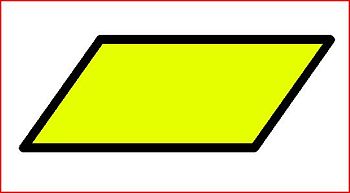Parallelogram
A parallelogram is a 4-sided geometric figure in a plane, where each side is parallel to the side it does not share a vertex with. As a consequence of the definition, a parallelogram is convex. It can be proven that each pair of opposite sides has equal lengths.
Special cases of parallelograms include rhombi, where the lengths of all sides are equal, rectangles, where the four angles are equal (and 90 degrees), and squares, where all four sides and all four angles are equal.
The area of a parallelogram is equal to the length of one side multiplied by the distance between the lines containing that side and the opposite side. Alternately, it can be calculated as the product of the lengths of two adjacent sides multiplied by the sine of the angle between the sides.
